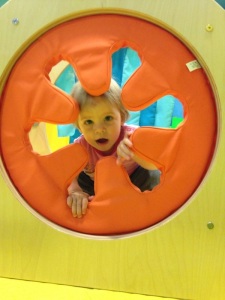verzija na hrvatskom jeziku (in Croatian language)
First of all, how does an entrance to a new place, especially a big, shiny, loud, crowded place such as a shopping center affect your child? Does your child rush into it or has a meltdown as soon as your car makes a turn to the shopping center’s parking lot? Take your answer to this question as a guide to your shopping center experience.
If your child does not like going into the malls, you don’t have to avoid it. Do it gradually and observing child’s reactions. If your child starts screaming at the parking lot, try making that your goal – safely parking the car, but not exiting from it. Next time, try exiting the car but not going inside the mall, but perhaps until the main entrance. What is important is that you always tell your child in a calm voice (whisper to those overly stimulated to sounds) what is your agenda. You want your child to be in a control over the situation. When the child feels they are in control, things will get a lot easier. If they feel activities are too fast for them, if they are loosing that control, they will become upset, anxious and perhaps even have a tantrum. So, just comment on your plan to your child no matter how old they are and no matter how much you think they can comprehend; “we will park in the spot right here on the left and then mommy will turn off the car. I’m doing it, look, 1…2…3… car is off”. You can use simpler sentences, or break it apart in more smaller ones or if your child is bigger, you can add more details. If your child is verbal, you can have them count or choose the parking spot. Engaging your child in these simple activities gives them confidence and control they badly need to stay regulated.
Once you slowly get inside the mall, take a moment to see what is around you to make your anxious child feel better and back in control. You can take your child in your arms if they are small and tell them what you see around them; lights, coffee places, ornaments, music playing in the background, shops, carts, people, etc. Give a minute or two to your child to comprehend what is going on around them. When you see the moment is right, continue to your chores. Most likely next time you will not have to go through this process again. If you do, that’s ok, too. Give your child the time they need. If you are not able to take those few minutes extra, or start early, and let’s be realistic, we are sometimes on a very tight schedule, rather leave your child with somebody else and not “drag” them into a place where they will feel uncomfortable.
Nowadays, most of the larger malls have some sort of playground for children to play at while parents are doing their shopping. Some have rules about leaving your child unattended, some are paid, some are free but most of them are a good source of sensory input. Larger playgrounds have all kinds of climbing equipment, ball pits, slides and tunnels. Use it! See if your child is overly sensitive to sounds. If it is, then choose a moment when there are less loud children around. Same goes with children who are overly sensitive to moving visual stimuli. If there is a lot of running children around, your child might freeze and not enjoy this fun playground. At first, I would choose some activities there that your child is familiar with, just to get some confidence in the space and its own possibilities. Once you feel your child is ok with the environment, you can propose going to an activity your child is not very thrilled about. Slowly and gradually. It’s always good to leave it up to your child to do it first so they use their own creativity and motor planning on how to achieve the goal of that activity, but if you see your child needs some encouragement, you can do it yourself first.

If you have no time for the playground or there isn’t one at your mall, try engaging your child in the chores you need to do. Children who need vestibular input can enjoy a ride in the shopping cart plus they can easily put the groceries into the cart itself. Let them choose out of the two products that are relevant to them; e.g. which juice or cereals to buy. However, limit your options to two or three to choose from for smaller children, especially those that do not use verbal language.
If your child likes changing activities very often, try to do your shopping chores quickly because we don’t want to overstimulate the child. You do not have to leave the store right away, try prolonging the period for one activity, but do not go overboard. You will see the signs from your child: not engaging in your activities anymore (“getting bored”), looking tired, dragging themselves on the floor, asking you to leave, “nagging” and everything else up to a tantrum. Sometimes children go through the spectrum of signs very quickly, and some children skip to crying right away. I’m sure knowing your child, you will instinctively know what is the right thing to do in that moment; leaving or staying – but the right thing is not always easy or possible, I know.